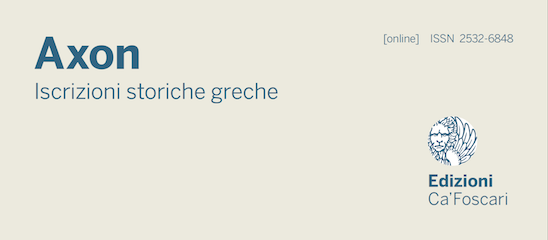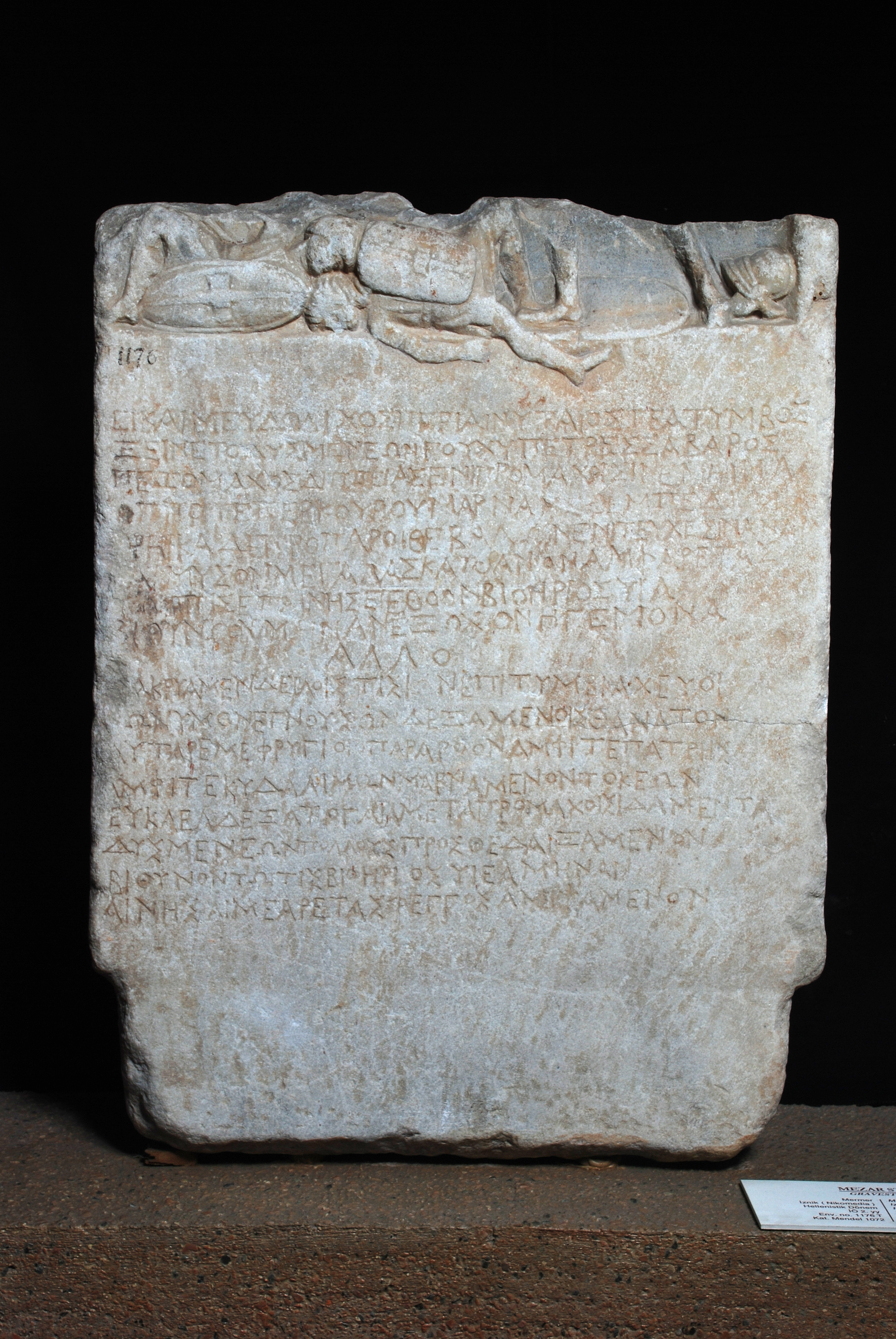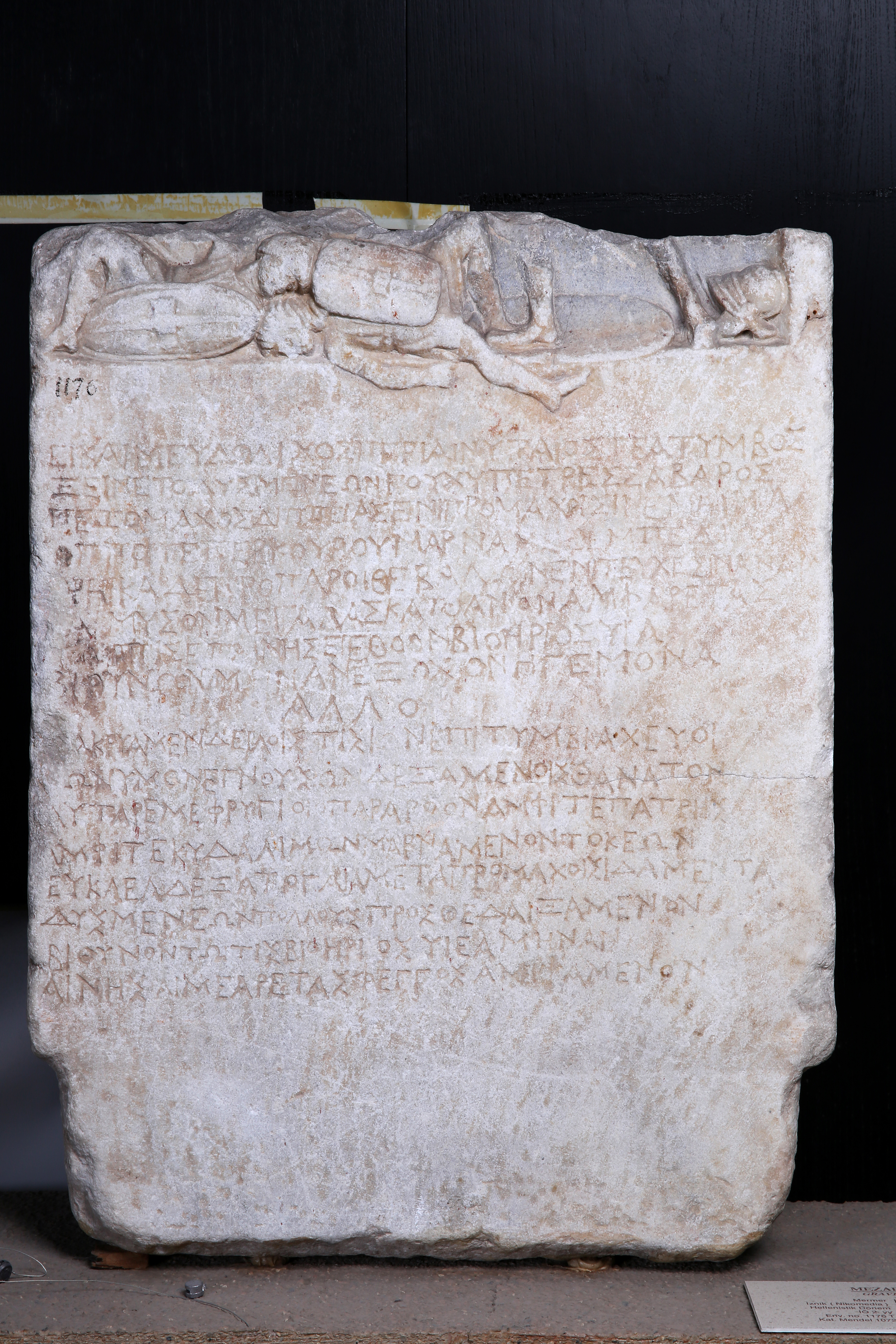


| ID AXON | 424 | |||||||||||||||||||||||||||||||||||||||||||
| Autore/i | Pietro Ortimini | |||||||||||||||||||||||||||||||||||||||||||
| Data | 29-7-2023 | |||||||||||||||||||||||||||||||||||||||||||
| Titolo | Epitafi per Menas di Bitinia caduto in battaglia | |||||||||||||||||||||||||||||||||||||||||||
| Riassunto (massimo 650 caratteri spazi inclusi) | La stele con bassorilievo, rinvenuta a Cihanköy, a nord-ovest del lago di İznik, e conservata presso il Museo Archeologico di Istanbul dal 1901, riporta un'iscrizione doppia composta da due epitafi in distici elegiaci dedicati all'ufficiale (hegemon) Menas di Bitinia, caduto in una battaglia svoltasi verosimilmente nella piana di Curupedio, nei pressi del fiume Frigio in Lidia. Sull'identificazione della battaglia, si è ipotizzato la battaglia di Curupedio tra Lisimaco (I) e Seleuco I (281 a.C.), la battaglia di Magnesia tra Roma e Antioco III (190/189 a.C.), i conflitti tra il regno di Bitinia e quello di Pergamo (208-183 a.C.; 156-154 a.C.). | |||||||||||||||||||||||||||||||||||||||||||
| Per il commento vai alla rivista | ||||||||||||||||||||||||||||||||||||||||||||
| Supporto | Stele, funeraria ; marmo bianco; 50 × 66 × 7 cm, (Mendel 1914, 20; Pfuhl-Möbius II nr. 1269; I.Mus. Iznik nr. 751; I.Kios nr. 98); 48 × 63 cm (Mendel 1900, 380). Integro, manca la parte superiore del bassorilievo posto al di sopra della stele (vd. Figura 3). Nel bassorilievo è raffigurata verosimilmente la scena di battaglia che precede la morte del defunto, descritta nel primo dei due epigrammi (ll. 5-6). Entrambi i lati lunghi della stele presentano un intaglio a formare un perno d'incastro (vd. Figura 1; 2). Secondo Mendel (1914, 305), il retro della stele, levigato per l'usura, sembra essere stato impiegato come pavimento o come pietra per lavare. | |||||||||||||||||||||||||||||||||||||||||||
| Cronologia | III secolo - II secolo a.C. [281 a.C. Mendel 1900, 381-2; 190-189 a.C. Corsten I.Kios nr. 98; 159-154 a.C. Bar-Kochva 1974, 20]. | |||||||||||||||||||||||||||||||||||||||||||
| Tipologia | Epigrafe sepolcrale. | |||||||||||||||||||||||||||||||||||||||||||
| Ritrovamento |
| |||||||||||||||||||||||||||||||||||||||||||
| Luogo di conservazione | Turchia, Istanbul, İstanbul Arkeoloji Müzeleri, nr. inv. 1176. | |||||||||||||||||||||||||||||||||||||||||||
| Scrittura |
| |||||||||||||||||||||||||||||||||||||||||||
| Lemma | Mendel 1900, 380-2, nr. 27, con facs.; Keil 1902; Mendel 1914, 305-7, nr. 1072, con facs.; Geffcken 1916, 76-7, nr. 190; HGE nr. 91; Beloch 1927, 458-61; Peek, GVI nr. 1965; Peek, Grabgedichte nr. 268; Pfuhl-Möbius II nr. 1269, tav. 332 [Steinepigramme II nr. 09/05/16, con fig.]; I.Mus. Iznik nr. 751; I.Kios nr. 98 [Paganoni 2019 a, 158]; Bar-Kochva 1974, tav. 1; Corsten 1987, 196-9. | |||||||||||||||||||||||||||||||||||||||||||
| Testo |
| |||||||||||||||||||||||||||||||||||||||||||
| Apparato | 2 δυσμενέων οὐχ ed. pr. || 3 ἱππείας ed. pr. | ἐν προμάχοισιν ed. pr. || 4 μάρναμ[αι ἐ]μ ed. pr.; μαρνά[μεθ' ἐ]μ Keil; μαρνάμε̣θ̣' ἐμ Pfuhl-Möbius | πεδίω[ι] Keil, (ΠΕΔΙΩ facs. in Mendel 1900) || 5 [Θ]ρήϊκα ed. pr. | ἐν τεύχεσιν ἅ[μα] ed. pr.; ἐν τεύχεσιν ἄ[νδρα] Keil || 6 [κα]ὶ ed. pr.; [κ]αὶ Peek 1955; κ̣α̣ὶ Pfuhl-Möbius || 7 τῶι τις dub. scripsi coll. l. 16 τῶι τις, duae lineae rectae inter Ι et Τ inscriptae esse videntur; [τῷ] τις ed. pr.; [τ]ῶ τις Keil; τῶ τις Mendel 1914; [τ]ῷ τις Geffcken; [τ]ῶι τις Hiller von Gaertringen; τ̣ῶι <τ>ις Şahin, qui legit ̣ΩΙΠΙΣ in lapide; τ̣ῶι τ̣ις Corsten 1987 || 8 Βιθυνὸν ed. pr.; Β̣ι̣θυνὸ̣ν̣ Pfuhl-Möbius | Μη̣νᾶν Pfuhl-Möbius || 10 [δ]άκρυα ed. pr. | ἐπὶ τυμβία Corsten 1985 | χε̣ύοι Corsten 1985 || 11 [ν]ώνυμον ed. pr. || 15 δ' ἀϊξάμενον ed. pr. || 16 τῷ ed. pr.; τῶ Keil, (ΤΩΤΙΣ facs. in Mendel 1900) || 17 αἰνήσα̣ι Pfuhl-Möbius. | |||||||||||||||||||||||||||||||||||||||||||
| Traduzione |
| |||||||||||||||||||||||||||||||||||||||||||
| Bibliografia | Chantraine, DELG = Chantraine, P. (1968-1980). Dictionnaire étimologique de la langue grecque. Histoire des mots, terminé par O. Masson, J.-L. Perpillou, J. Taillardat, avec le concours de F. Bader, J. Irigoin, D. Lecco, P. Monteil, sous la direction de M. Lejeune, voll. I-IV. Paris. FGE = Page, D.L. (ed.) (1981). Further Greek Epigrams. Epigrams before A.D. 50 from the Greek Anthology and Other Sources, not Included in Hellenistic Epigrams or the Garland of Philip. Cambridge. Gignac, Grammar 1 = Gignac, F.T. (1976). A Grammar of the Greek Papyri of the Roman and Byzantine Periods vol. 1. Milano. GP = Gow, A.S.F.; Page, D.L. (a cura di) (1968). The Greek Anthology. The Garland of Philip and some Contemporary Epigrams. 2 vols. Cambridge. Guarducci, Epigrafia greca I = Guarducci, M. (1967). Epigrafia Greca I. Caratteri e storia della disciplina. La scrittura greca dalle origini all'età imperiale. Roma. HE = Gow, A.S.F.; Page, D.L. (eds.) (1965). The Greek Anthology. Hellenistic Epigrams, 2 vols. Cambridge. HGE = Hiller von Gaertringen, F. (1926). Historische griechische Epigramme. Bonn. I.Kios = Corsten, T. (1985). Die Inschriften von Kios. Bonn (IGSK Band 29). I.Mus. Iznik = Şahin, S. (a cura di) (1979-1987). Katalog der antiken Inschriften des Museums von Iznik (Nikaia), I-II 1/3. Bonn (IGSK Band 9-10 1/3). LGPN = Fraser, P.M.; Matthews, E. (eds.) (1987-2013). A lexicon of Greek personal names, I-VB. Oxford. Peek, Grabgedichte = Peek, W (a cura di) (1960). Griechische Grabgedichte: Griechisch und Deutsch. Berlin. Peek, GVI = Peek, W (Hrsg) (1955). Griechische Vers-Inschriften, I. Berlin. Pfuhl-Möbius II = Pfuhl, E.; Möbius, H. (1979). Die ostgriechischen Grabreliefs II. Mainz. Robert, Hellenica IV = Robert, L. (1948). Hellenica: Recueil d'épigraphie, de numismatique et d'antiquités grecques IV. Epigrammes du Bas-Empire. Paris. Steinepigramme II = Merkelbach, R.; Stauber, J. (Hrsgg.) (2001). Steinepigramme aus dem griechischen Osten. II. Die Nordküste Kleinasiens (Marmarameer und Pontos). München, Leipzig. Wilhelm, Beiträge = Wilhelm, A. (1909). Beiträge zur griechischen Inschriftenkunde. Wien. Agosti, G. (2007). «Cultura greca negli epigrammi epigrafici di età tardoantica». Incontri di Filologia Classica, 3-18. Agosti, G. (2008). «Epigrammi lunghi nella produzione epigrafica tardoantica». Morelli, A.M. (a cura di), Epigramma longum: da Marziale alla tarda antichità: atti del Convegno internazionale (Cassino, 29-31 maggio 2006). Cassino, 663-92. Agosti, G. (2010). «Eisthesis, divisione dei versi, percezione dei cola negli epigrammi epigrafici in età tardoantica». S&T, 8, 67-98. Alfieri Tonini, T. (2003). «Iscrizioni funerarie greche: l’apostrofe al passante». Acme, 16, 62-71. Barbantani, S. (2014). «“Déjà la pierre pense où votre nom s’inscrit”. Identity in context in verse epitaphs for Hellenistic soldiers». Hunter, R.; Rengakos, A.; Sistakou, E. (eds.), Hellenistic Studies at a Crossroads. Exploring Texts, Contexts and Metatexts. Berlin, Boston, 301-34. Barbantani, S. (2018). «‘Fui buon poeta e buon soldato’. Kleos militare e paideia poetica negli epigrammi epigrafici ellenistici ». Eikasmos, 29, 283-312. Barigazzi, A. (1952). «Sopra Alcuni Nuovi Epigrammi Ellenistici». Hermes, 80, 494-6. Bar-Kochva, B. (1974). «‘Menas’ inscription and Curupedion». SCI, 1, 14-23. Beloch, K.J. (1925). Griechische Geschichte. Vierter Band. Die griechische Weltherrschaft. Erste Abteilung. Berlin, Leipzig. Beloch, K.J. (1927). Griechische Geschichte. Vierter Band. Die griechische Weltherrschaft. Zweite Abteilung. Berlin, Leipzig. Bevan, E.R. (1902). The House of Seleucus, I. London. Bruss, J.S. (2005). Hidden Presences: Monuments, Gravesites, and Corpses in Greek Funerary Epigram. Leuven, Paris, Dudley. Chaniotis, A. (a cura di) (2005). War in the Hellenistic World. A Social and Cultural History. Oxford, Malden (MA). Chantraine, P. (1953). Grammaire Homérique, Tome II, Syntaxe . Paris. Chantraine, P. (a cura di) (1961). Morphologie historique du grec. Paris 2a ed. Chantraine, P. (a cura di) (2013). Grammaire homérique I. Phonétique et morphologie. Paris Nouvelle édition revue et corrigée par Michel Casevitz. Ciani, M.G. (1974). ΦΑΟΣ e termini affini nella poesia greca. Introduzione a una fenomenologia della luce. Firenze. Corsten, T. (1987). «Über die Schwierigkeit, Reliefs nach Inschriften zu datieren». MDAI(I), 37, 187-99. Corsten, T. (2007). «Thracian personal names and military settlements in Hellenistic Bithynia». PBA, 148, 121-33. Dana, D. (2014). Onomasticon Thracicum. Atene. Dana, M. (2020). «Local culture and regional cultures in Propontis and Bithynia». De Hoz, M.P.; García Alonso, J.L.; Guichard Romero, L.A. (eds.), Greek Paideia and Local Tradition in the Graeco-Roman East. Leuven, 39-72. Denniston, J.D. (1954). The Greek Particles . Oxford. Dintsis, P. (1986). Hellenistische Helme. Roma. Dumitru, A.G. (2013). «Les Séleucides et les Balkans: les Thraces dans l'armée séleucide». Rufin Solas, A. (éd.), Armées grecques et romaines dans le nord des Balkans : conflits et intégration des communautés guerrières. Gdańsk-Toruń , 69-89. Fabbro, M.E. (2019). «La luce: metafora strutturale in Pindaro». Lavecchia, S. (a cura di), Immagini della luce. Dimensioni di una metafora assoluta. Milano; Udine, 13-55. Fantuzzi, M. (2008). «La doppia gloria di Menas (e di Filostrato)». Morelli, A.M. (a cura di), Epigramma longum. Da Marziale alla tarda antichità. From Martial to Late Antiquity. «Atti del convegno internazionale. Cassino, 29-31 maggio 2006», II. Cassino, 603-22. Fantuzzi, M. (2020). The Rhesus Attributed to Euripides. Cambridge. Gabelko, O. (2005). История Вифинского царства . Санкт-Петербург. Garulli, V. (2008). «L’epigramma longum nella tradizione epigrafica sepolcrale greca». Morelli, A.M. (a cura di), Epigramma longum: da Marziale alla tarda antichità: atti del Convegno internazionale (Cassino, 29-31 maggio 2006). Cassino, 623-62. Garulli, V. (a cura di) (2012). Byblos lainee. Epigrafia, letteratura, epitafio. Bologna. Garulli, V. (2014). «Stones as books: the layout of Hellenistic inscribed poems». Harder, M.A.; Regtuit, R.F.; Wakker, G.C. (a cura di), Hellenistic Poetry in Context. Leuven, Paris, Walpole MA, 125-69. (2014a) Garulli, V. (2014). «Gli epitafi greci per animali. Fra tradizione epigrafica e letteraria». Pistellato, A. (a cura di), Memoria poetica e poesia della memoria. La versificazione epigrafica dall'antichità all'umanesimo. Venezia, 27-64. (2014b) Geffcken, J. (1916). Griechische Epigramme. Heidelberg. Gow, A.S.F.; Page, D.L. (1968). The Greek Anthology. The Garland of Philip and some Contemporary Epigrams, I-II. Cambridge. Grainger, J.D. (1990). Seleukos Nikator: Constructing a Hellenistic Kingdom. London, New York. Habicht, C.. s.v. «Zipoites I». RE X A.1, coll. 448-455. Habicht, C.. s.v. «Prusias I». RE XXIII.1, coll. 1086-1107. Habicht, C.. s.v. «Prusias II ». RE XXIII.1, coll. 1107-1128. Habicht, C. (1956). «Über die Kriege Zwischen Pergamon und Bithynien». Hermes, 84, 90-110. Hannestad, L. (1996). «This contributes in no small way to one's reputation: The Bithynian Kings and Greek Culture». Bilde, P.; Engberg-Pedersen, T.; Hannestad, L.; Zahle, J. (eds.), Aspects of Hellenistic Kingship. Aarhus, 67-99. Hannestad, L. (2020). Nicator Seleucus I and his empire. Aarhus. Heilmann, L. (a cura di) (1963). Grammatica storica della lingua greca. Torino. Horrocks, G. (2010). Greek: A History of the Language and Its Speakers. Malden (MA), Oxford, Chichester (WS). Hutchinson, G.O. (2016). «Pentameters». Sistakou, E.; Rengakos, A. (edd.), Dialect, Diction and Style in Greek Literary and Inscribed Epigram. Berlin, Boston. Jacques, J.-M. (2007). Nicandre. Œuvres. Tome III : Les Alexipharmaques. Lieux parallèles du Livre XIII. Des Iatrica d'Aétius. Paris. Keil, B. (1902). «ΚΟΡΟΥ ΠΕΔΙΟΝ». RPh, 26, 257-62. Kirstein , R. (2002). «Companion Pieces in the Hellenistic Epigram (Call. 21 and 35 Pf.; Theoc. 7 and 15 Gow; Mart. 2.91 and 2.92; Ammianos AP 11.230 and 11.231)». Harder, M.A.; Regtuit, R.F.; Wakker, G.C. (eds.), Hellenistic Epigrams. Leuven, 113-35. Korzeniewski, D. (1968). Griechische Metrik. Darmstadt. Kosmin, P.J. (2014). The Land of the Elephant Kings. Space, Territory, and Ideology in the Seleucid Empire. Cambridge, Mass.; London. Kühner, R.; Gerth, B. (1898). Ausführliche Grammatik der griechischen Sprache von Dr. Raphael Kühner. Zweiter Teil: Satzlehre. Dritte Auflage in zwei Bänden in neuer Bearbeitung besorgt von Dr. Bernhard Gerth, I. Hannover, Leipzig (https://archive.org/details/ausfhrlichegram02khgoog/page/n9/mode/2up). Kühner, R.; Gerth, B. (1904). Ausführliche Grammatik der griechischen Sprache von Dr. Raphael Kühner. Zweiter Teil: Satzlehre. Dritte Auflage in zwei Bänden in neuer Bearbeitung besorgt von Dr. Bernhard Gerth, II. Hannover, Leipzig (https://archive.org/details/p2ausfhrlichegra02khuoft). Landucci Gattinoni, F. (1990). «La morte di Antigono e di Lisimaco». Sordi, M. (a cura di), "Dulce et decorum est pro patria mori". La morte in combattimento nell'antichità. Milano, 111-26. Landucci Gattinoni, F. (a cura di) (1992). Lisimaco di Tracia: un sovrano nella prospettiva del primo ellenismo. Milano. Lattimore, R. (a cura di) (1962). Themes in Greek and Latin epitaphs. Urbana 2nd ed. 1962. Launey, M. (éd.) (1949-1950). Recherches sur les armées hellénistiques, I-II. Paris. Lelli, E.; Mosino, F. (a cura di) (2019). Epitaffi greci. La Spoon River ellenica di W. Peek. Firenze, Milano. Loraux, N. (1981). L'invention d'Athènes: histoire de l'oraison funèbre dans la "cité classique" . Paris. Lund, H.S. (a cura di) (1992). Lysimachus. A study in Early Hellenistic Kingship. London, New York. Ma, J. (1999). Antiochos III and the Cities of Western Asia Minor . Oxford. McLean, B.H. (a cura di) (2002). An Introduction to Greek Epigraphy of the Hellenistic and Roman Periods from Alexander the Great down to the Reign of Constantine (323 B.C.-A.D. 337). Ann Arbor. Mehl, A. (1986). Seleukos Nikator und sein Reich. Leuven. Mendel, G. (1900). «Inscriptions de Bithynie». BCH, 24, 361-426. Mendel, G. (1914). Catalogue des sculptures grecques, romaines et byzantines, III. Costantinople. Michels, C. (2014). «Die Kleinkönigreiche Bithynien, Pontos und Kappadokien». Ehling, K.; Weber, M. (Hrsgg.), Hellenistische Königreiche. Darmstadt, 135-40. Muccioli, F. (2013). Gli epiteti ufficiali dei re ellenistici. Stuttgart. (Historia – Einzelschriften, 224). Muccioli, F. (2019). Storia dell'Ellenismo. Bologna. Paganoni, E. (2019). «Bitinia e Paflagonia tra Alessandro e i Diadochi (334-301 a.C.)». Prandi, L. (a cura di), EstOvest. Confini e conflitti fra Vicino Oriente e mondo Greco-romano. Roma, 137-167. (2019b) Paganoni, E. (2019). Forging the Crown. A History of the Kingdom of Bithynia from its Origin to Prusias I. Roma-Bristol. (2019a) Page, D.L. (a cura di) (1981). Further Greek Epigrams. Epigrams before A.D. 50 from the Greek Anthology and Other Sources, not Included in Hellenistic Epigrams or the Garland of Philip (Revised and Prepared for Publication by R.D. Dawe and J. Diggle). Cambridge. Palumbo Stracca, B.M. (1987). «Differenze dialettali e stilistiche nella storia dell'epigramma greco». Bolognesi, G.; Pisani, V. (a cura di), Linguistica e filologia. Atti del VII congresso internazionale di linguisti tenuto a Milano nei giorni 12-14 settembre 1984. Brescia, 429-34. Rist. in L. Bettarini (a cura di), B.M. Palumbo Stracca, ΣΥΜΦΩΝΙΑ. Studi di dialettologia e metrica greca, Padova 2013. Peek, W (1938). «Metrische Inschriften. Tafel 1-6». Crome, J.F. (Hrsg), Mnemosynon Theodor Wiegand. München, 14-42. Pfeijffer, I.L. (1999). Three Aeginetan Odes of Pindar : A Commentary on Nemean V, Nemean III and Pythian VIII. Leiden, Boston, Köln. Pfuhl, E. (1932). «Zwei Kriegergrabmäler ». AA, 46, 2-7. Pfuhl, E. (1933). «Zum Grabstein des Bithyners Menas». AA, 48, 751-4. Race, W.H. (1983). «Negative Expressions and Pindaric ΠΟΙΚΙΛΙΑ». TAPhA, 113, 95-122. Radt, S. (2004). Strabons Geographika, III, Buch IX-XIII: Text und Übersetzung. Göttingen. Radt, S. (2008). Strabons Geographika, VII, Buch IX-XIII: Kommentar. Göttingen. Ruggeri, L. (2019). «Osservazioni sul testo dell'epitafio di Platôr figlio di Sakolas (SEG 42 329)». SCO, 65/2, 151-162. Scholten, J.B. (2007). «Building Hellenistic Bithynia». Elton, H.; Reger, G. (eds.), Regionalism in Hellenistic and Roman Asia Minor. Bordeaux, 17-24. Sironen, E. (2001). «Recensione di Steinepigramme aus dem griechischen Osten, hrsg. v. R. Merkelbach, J. Stauber, II-III, München-Leipzig 2001». Arctos, 35, 265-267. Struffolino, S. (2003). «L’evoluzione dell’apostrofe al passante nelle iscrizioni di età ellenistico-romana». Acme, 16, 99-103. Taylor, M.J. (2013). Antiochus the Great. Barnsley. Tentori Montalto, M. (2017). Essere primi per il valore. Gli epigrammi funerari greci su pietra per i caduti in guerra (VII-V sec. a.C.). Pisa, Roma. Tosi, R. (2018). Dizionario delle sentenze latine e greche. Milano. Tueller, M.A. (2008). Look Who’s Talking. Innovations in Voice and Identity in Hellenistic Epigram. Leuven, Paris, Dudley. Vermeule, C.C. (1971). «Dated monuments of Hellenistic and Graeco-Roman popular art in Asia Minor». Mitten, D.G.; Pedley , J.G.; Scott, J.A. (eds.), Studies presented to George M. A. Hanfmann. Mainz, 169-76. Vitucci, G. (a cura di) (1953). Il regno di Bitinia. Roma. Wilhelm, A. (1909). Beiträge zur griechischen Inschriftenkunde. Wien. Wilhelm, A. (1939). «Zur Syntax des Griechischen». NAWG, N.F. Bd. 3, Nr. 5. | |||||||||||||||||||||||||||||||||||||||||||
| Immagini | ||||||||||||||||||||||||||||||||||||||||||||
| Collegamenti |
|
Alcuni browser (in particolare Chrome e versioni molto recenti di Firefox) non rendono correttamente un gruppo di caratteri presenti nel testo di alcune iscrizioni, per lo più arcaiche. I caratteri che possono presentare il problema sono riportati nella sottostante tabella, in cui si può immediatamente verificare il comportamento del browser in uso. Nel caso sfavorevole, infatti, nella seconda riga al posto della lettera apparirà unl'icona sempre uguale a significare l'incapacità di rappresentarla:

|

|

|

|

|

|

|

|

|

|
| | | | | | | | | | |
Le soluzioni che vi proponiamo sono le seguenti:
- impiegare un browser che non presenti il problema (suggeriamo ad esempio IExplorer 11 o successivi per Windows; Safari per Mac);
-
installare nel vostro computer il font Cardo di David Perry. A tale scopo è necessario:
- scaricare il font Cardo da qui;
- installarlo nel vostro computer;
- spuntare la casella sottostante (la scelta sarà memorizzata per le sessioni successive).


 alpha;
alpha;
 zeta;
zeta;
 theta;
theta;
 theta;
theta;
 ny;
ny;
 ny;
ny;
 omicron;
omicron;
 omicron;
omicron;
 omicron;
omicron;
 pi;
pi;
 pi;
pi;
 sigma.
sigma.
